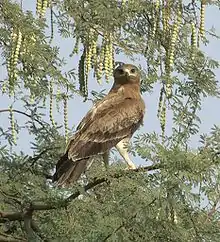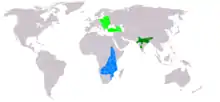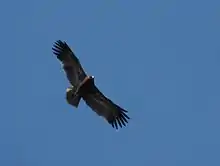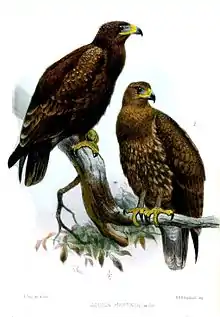Indian spotted eagle
The Indian spotted eagle (Clanga hastata) is a large South Asian bird of prey. Like all typical eagles, it belongs to the family Accipitridae. The typical eagles are often united with the buteos, sea eagles and other more heavyset Accipitridae, but more recently it appears as if they are less distinct from the more slender accipitrine hawks.
| Indian spotted eagle | |
|---|---|
 | |
| Adult Note wide mouth and dark eyes | |
| Scientific classification | |
| Kingdom: | Animalia |
| Phylum: | Chordata |
| Class: | Aves |
| Order: | Accipitriformes |
| Family: | Accipitridae |
| Genus: | Clanga |
| Species: | C. hastata |
| Binomial name | |
| Clanga hastata (Lesson, 1834) | |
 | |
| Range of C. hastata in dark green | |
| Synonyms | |
|
Aquila hastata | |
Description

The Indian spotted eagle is about 60 cm in length and has a wingspan of 150 cm. It is broad-headed, with the widest mouth of all spotted eagles.[2] This species has a lighter coloration overall compared to its relatives, with a darker iris that makes the eyes appear darker than the plumage (rather than the other way around as in the northern spotted eagles). Adults can be told apart from the greater spotted eagle by its lighter color, darker eyes, and habitat preference. After about three or four months the young birds are glossy brown with the tips of the head and neck feathers being creamy and giving a spotted appearance. The upper tail coverts are light brown with white giving a barred appearance. The median coverts have large creamy spots. After about eighteen months the bird moults and becomes a darker shade and has less spots.[3] Some older juveniles, unlike the lesser and greater species, are not strongly spotted at all, making the common name somewhat misleading, and also lack the creamy buff nape patch of the juvenile lesser spotted eagle.
Distribution and habitat
The Indian spotted eagle is native in Bangladesh, India, Myanmar and Nepal, where it prefers subtropical and tropical dry forests to plantations and arable land. It is vagrant in Pakistan. In Nepal, it is resident and breeding in Chitwan and Bardia National Parks, in Sukla Phanta and Koshi Tappu Wildlife Reserves and in some unprotected areas in the Terai.[4] In India, it is distributed sparingly over the Gangetic plains, in the east up to Manipur, in Madhya Pradesh and southern Orissa, but in the south limited to Kotagiri and Mudumalai, Nilgiris district, Tamil Nadu and Tumakuru, Karnataka.[5]
This species can often be approached quite closely for a large raptor. Unlike the greater spotted eagle, which is a winter visitor to Indian wetlands, this species does not show any special affinity for wetland habitats.
Systematics, taxonomy and evolution

The Indian spotted eagle was earlier considered as the resident of eastern subspecies of the lesser spotted eagle but has proven quite distinct and readily separable by morphological, behavioral, ecological and DNA sequence data. The Indian lineage seems to have diverged around the middle Pliocene, perhaps some 3.6 million years ago,[6] from the common ancestor of the lesser and greater spotted eagles. The "proto-spotted eagle" probably lived in the general region of Afghanistan, being split into a northern and a southern lineage when both glaciers and deserts advanced in Central Asia as the last ice age began.[2][7][8]
The spotted eagles as a group although quite distinct from the typical members, were formerly included in the genus Aquila, the "true eagles". They are now placed in their separate genus Clanga
References
- BirdLife International (2013). "Clanga hastata". IUCN Red List of Threatened Species. 2013. Retrieved 26 November 2013.CS1 maint: ref=harv (link)
- Parry, S.J., Clark, W.S., Prakash, V. (2002) On the taxonomic status of the Indian Spotted Eagle Aquila hastata. Ibis Volume 144 Issue 4: 665 - 675
- Anderson A (1875). "Corrections of and Additions to "Raptorial Birds of North-western India". Proceedings of the Zoological Society of London: 16–27.
- BirdLife International (2009) Species factsheet: Aquila hastata. online
- Shivprakash, A. Kishen Das, K.R., Shivanand, T., Girija, T., Sharath, A. (2006) Notes on the breeding of the Indian Spotted Eagle Aquila hastata. Indian Birds Vol. 2 No. 1 (January–February 2006): 2-4 download pdf Archived 2011-07-20 at the Wayback Machine
- The estimate in Väli (2006) is certainly incorrect; it uses a molecular clock that is appropriate for small passerines with half the generation times of eagles.
- Rasmussen, P.C., Anderton, J.C. (2005) Birds of South Asia: The Ripley Guide. Smithsonian Institution and Lynx Edicions, Washington, DC and Barcelona.
- Väli, Ü (2006) Mitochondrial DNA sequences support species status for the Indian Spotted Eagle Aquila hastata. Bulletin of the British Ornithologists' Club 126 (3): 238-242. download pdf Archived 2007-09-27 at the Wayback Machine
Further reading
- Parry, S.J.; Clark, W.S. & Prakash, V. (2002): On the taxonomic status of the Indian Spotted Eagle Aquila hastata. Ibis 144(4): 665–675. doi:10.1046/j.1474-919X.2002.00109.x (HTML abstract)
- Rasmussen, Pamela C. & Anderton, John C. (2005): Birds of South Asia - The Ripley Guide. Lynx Edicions, Barcelona. ISBN 84-87334-67-9
- Väli, Ülo (2006): Mitochondrial DNA sequences support species status for the Indian Spotted Eagle Aquila hastata. Bull. B.O.C. 126(3): 238–242. PDF fulltext
External links
| Wikimedia Commons has media related to Clanga hastata. |
| Wikispecies has information related to Clanga hastata. |
